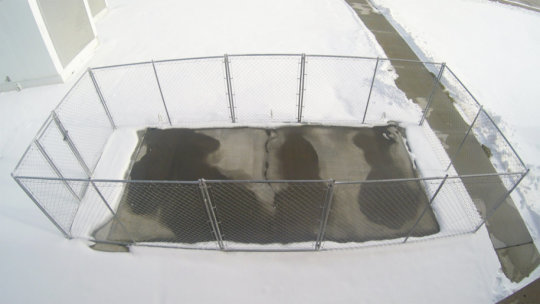As much of the world suffer snowy weather this time of year, many drivers, as they slip and slide along their city’s frozen roads or stagnate in traffic jams caused by other vehicles slipping and sliding into something else, wonder why the road hasn’t been cleared by plough or grit, or why no one has invented a frost-free type of roadway.
The short answer is, they have. Just outside of Lincoln, Nebraska, the 150-foot Roca Spur Bridge, built in 2002, is the first and only – so far – to incorporate conductive concrete. Inlaid with 52 conductive slabs that have been using electricity to de-iced its surface for over thirteen years, the bridge demonstrates the kind of site that the concrete’s designer developed it for.
This winter, however, professor of civil engineering at the University of Nebraska – Lincoln Chris Tuan has been showing his material off to the Federal Aviation Administration, beginning a testing phase that will run right through until March 2016. And he now believes that the FAA will be scaling up the tests by employing the technology at a major U.S. airport.
“To my surprise, they don’t want to use it for the runways,” Tuan said. “What they need is the tarmac around the gated areas cleared, because they have so many carts to unload – luggage service, food service, trash service, fuel service – that all need to get into those areas.”
He goes on to add, “They said that if we can heat that kind of tarmac, then there would be (far fewer) weather-related delays.”
It hasn’t been introduced to the rest of the world’s colder highways as yet because, Tuan says, the cost is prohibitive. It would work out more efficient to use the conductive concrete at certain locations where ice is a known problem, like bridges, busy intersections and exit ramps, or where potholes form.
Potholes can originate from the excessive use of salt and de-icing chemicals corroding the concrete, which would no longer happen with conductive concrete. As an added bonus, thawing the Roca Spur Bridge through a three-day storm costs about $250, which is many times less what it would cost to cover it with truckloads of chemicals for the same time period.
Conductive concrete works by merely adding one part carbon particles and steel shavings to five parts regular concrete mix. A low current is then passed through the slabs, enough to melt snow and ice in minutes, yet it still remains safe to touch, walk or drive on. It’s very simple.
Tuan is so taken with his design; he’s employed it in his garden in chilly Nebraska. “I have a patio in my backyard that is made of conductive concrete,” he laughs, “So I’m practicing what I preach.”

